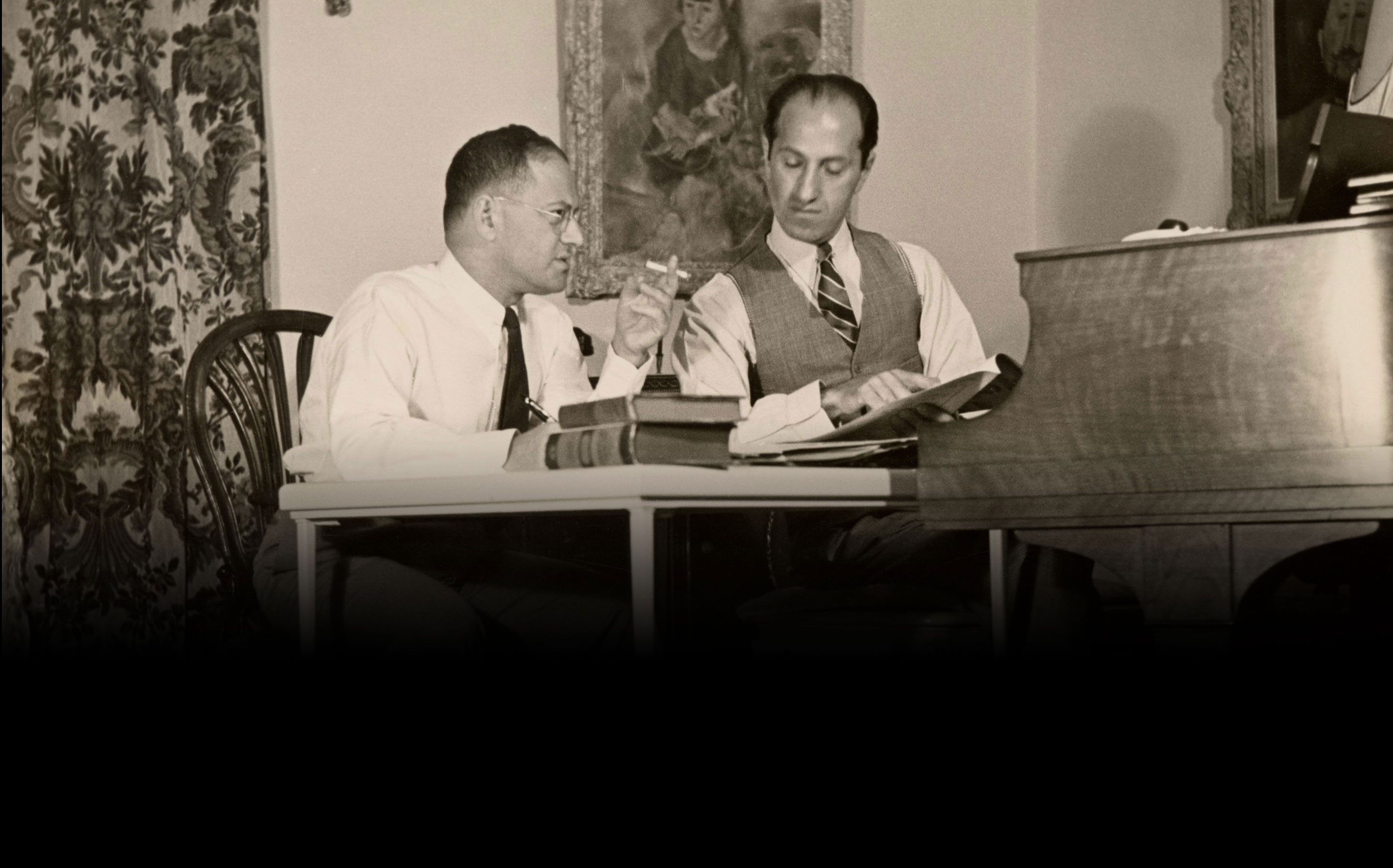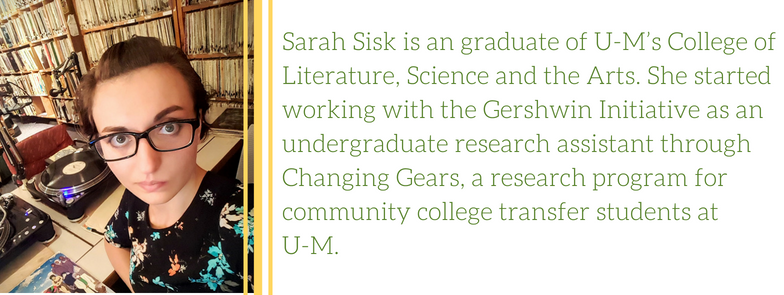George Gershwin, Futurist Composer?
George Gershwin’s career was concurrent with several bold Modernist movements, one of which was Futurism. On December 4, 1926, composer and movement had a moment of overlap, as Gershwin premiered his piano preludes at a “futurist” recital. Was this “futurist” concert just a bit of press hype, or did Gershwin really belong in this group of composers?
By Sarah Sisk
George Gershwin, composer: modern, daring, innovative, bursting with new traditions for a new age of music. But did that make him a Futurist? The headline for a December 5, 1926 New York Times review concerning a recital at Roosevelt Hall that previous Saturday afternoon, would suggest yes:
“FINAL ROOSEVELT RECITAL.
George Gershwin and Mme. d’Alvarez Give a ‘Futurist’ Program.”
The “futurist” program included Gershwin’s accompaniment of contralto Marguerite d’Alvarez as she sang a selection of popular songs, as well as performances by Gershwin of several of his piano works, including the premiere of his Five Piano Preludes. The New York Times chose to use the terms “futurist” and “jazz song” to describe Gershwin’s music, but the scare quotes simultaneously served to advertise and reject these qualities. In fact, both terms were still new and loosely defined in the 1920s. “Jazz songs,” while contentious as both a descriptor and a genre, eventually became synonymous with Gershwin’s popular music. But the “futurist” label holds an element of novelty even for the modern reader. Is this “futurist” recital a misnomer, or can we find connections between Gershwin, the 1926 recital, and the Futurist movement? Can Gershwin’s piano preludes, the highlight of the recital, be interpreted as Futurist music? And what, exactly, did Futurism mean in the 1920s?
A Brief History of Futurism
The Futurist movement arose in Italy at the end of the first decade of the twentieth century among artists who, concerned that their nation’s culture had become mired in the previous century’s traditions, developed revolutionary methods and philosophies in an effort to break from the past. Futurist art became known for its glorification of speed, technology, progress, and violence, and its visual style was recognizable by its frenetic, slashing angles and fractured composition.

Giacomo Balla, Abstract Speed + Sound (1913-14) Credit: 2017 Artists Rights Society (ARS), New York/SIAE, Rome
Futurist music, while less neatly defined than its visual counterpart, also pushed back against the past. Composers experimented with new forms and instrumentation, abandoning 19th-century conventions in favor of an emphasis on what might be more typically considered “noise.” Some went as far as fashioning their own instruments to achieve these ends. Luigi Russolo (1883–1947) invented a group of experimental instruments called Intonarumori, meaning “noise intoners.” These functioned to distill the “noise-sounds” from the cacophony of modern life into six sonic categories, whose classifications ranged from rumbles and roars to shouts, screams, and groans. In his 1913 Futurist manifesto entitled The Art of Noises, Russolo wrote: “We shall enjoy fabricating mental orchestrations of the banging of store shutters, the slamming of doors, the hustle and bustle of crowds, the din of railroad stations, foundaries [sic], spinning mills, printing presses, electric power stations, and underground railways.”
Futurism began to spread in the 1910s, making its way to Russia and later Paris, where it reached the attention of such Modernist composers as Igor Stravinsky. The movement traveled to America as well: Leo Ornstein, a Russian-born American composer and famed virtuoso pianist, was a leading U.S. Futurist known for his distinctly avant-garde repertoire. Other notable American Futurists include George Antheil, a friend (and occasional rival and critic) of Gershwin’s who spent a good portion of his career in Europe, earning notoriety for such pieces as “Airplane Sonata” (1921) and Ballet Mécanique (1924). Antheil and other Futurists delighted in upsetting the status quo of the classical music world throughout the 1920s—a decade that continued to roil with the urban and mechanical innovation captured by these artists.
What was Futurism to people in 1920s?
While hardly easy to define today, Futurism was an even less concrete concept in the 1920s. Much like “jazz,” the word came into popular use relatively quickly, without an entirely sound or common understanding of what it meant. In contemporary media coverage, “futurism” was often used interchangeably with the word “modernism” to signal works that broke with traditional procedures. For example, Gershwin’s friend and fellow composer Arnold Schoenberg was touted as “Germany’s Leading Futurist Composer” in a 1913 Chicago Daily News interview, though he is today better known as one of the key figures in the Expressionist movement and the founder of the Second Viennese School. Such nomenclature indicates the efficacy of “futurism” as a buzzword, but exactly what sorts of music fell under this banner was a matter of little discrimination. The frequent and often skeptical usage of “futurist” in early 20th-century reporting muddies the distinction between Futurist music and music that was more broadly Modernist.
George’s “futurist” recital
The flavor of media reporting surrounding “futurist” music creates a twist in the narrative of Gershwin’s December 4, 1926 recital: we are presented with a use of the term that has less to do with the artistic classification of his work, and more to do with his popular and critical reception as a whole. During this Saturday afternoon, George Gershwin accompanied singer Marguerite D’Alvarez in a performance that—much like his 1923 recital with Eva Gauthier, billed as a “Recital of Ancient and Modern Music for Voice”—sought to present jazz as a new art music. Most pertinently, it was at this recital that George Gershwin premiered his brand-new “Five Piano Preludes.” While his initial vision was of a modern cycle of twenty-four preludes in the tradition of Chopin and Debussy, Gershwin—having encountered his typical misfortune of time constraints—was forced to narrow the final product to five short piano pieces. Only three of the preludes survived to be published the following year, but vibrant descriptions of the five individual pieces remain. The first was a “vigorous, syncopated” jazzy piece; the second was more lyrical and nocturne-esque; the third contained a strong reminder of Chopin; the fourth was bluesy and languid, and the fifth combined a Spanish melody with a Charleston rhythm.
The Five Piano Preludes were the highlight of the recital, but were they the Futurist fare that was advertised? These preludes, each distinct in style and mood, generated a spectrum of reactions; critics remarked upon their innovative jazz and blues elements and noted parallels with Rhapsody in Blue, but they also drew heavily upon comparisons with Chopin and other European influences, with one critic noting a “French post-romantic” strain in one and a “Spanish flavor” in another. Far from attempting a Futurist departure from convention, these new pieces exhibited his penchant for fusing jazz and classical styles while evoking nineteenth-century classical traditions.
So…was George Gershwin a Futurist?
As our discussion of the preludes has demonstrated, George Gershwin is a difficult composer to pin down. He made his start in musical theater, and his early successes on Broadway and London’s West End cemented his reputation as a creator of popular songs—certainly not, according to the opinion of many of his critics and contemporaries, a suitable peer of “serious” composers. Nevertheless, Gershwin strove to achieve this status. He acquired formal training in classical composition, even as he continued to experiment with jazz and other popular music forms. No longer just a popular songwriter, Gershwin failed to fit comfortably among the American Modernists, many of whom were threatened by the runaway success of his Rhapsody in Blue and subsequently viewed him as a rival. Gershwin was frequently compared with the likes of Aaron Copland, George Antheil, and Virgil Thompson, but his compositions were commonly juxtaposed with, rather than grouped among, the achievements of these and other American contemporaries.

Christopher Richard Wynne Nevinson, The Arrival (c.1913) hared under the Creative Commons Licence CC-BY-NC-ND 3.0
With a musical legacy already multifaceted by his accomplishments on both the popular and classical stage, one might also identify where Gershwin engaged with Futurist ideas. His early vocation recording piano rolls dimly echoes the Futurists’ obsession with mechanical instruments, and is one of many ways he rode upon the cusp of the swift evolution of both music and technology throughout his career. His works were popularized largely through their artificial replication by record players, radio sets, and—in the 1930s—the silver screen. This comfortable intimacy with modern technology leached into his compositions as well. Aside from invoking the new and swiftly evolving elements of jazz and other popular music forms, his work on several occasions echoes the Futurists’ fascination with mimicking urban cacophony. A striking example is the creation of a city-soundscape in An American in Paris (1928), which, complete with taxi-horn “instruments,” invokes Russolo’s Futurist manifesto and “noise-sounds.” A similar urbanism in his other works impressed some in his contemporary audience, with Evening World critic Richard Stokes noting in his review of the 1926 “futurist” recital that the newly premiered preludes were “brief and glowing vignettes of New York life”. And yet even such works as An American in Paris, as well as the piano preludes themselves (inspired as they are by the 19th-century Romantics), also indicate an engagement with a deeper classical strain and Gershwin’s respect for, and keen awareness of, the musical past. In the end, whether it was an inadvertently apt description or merely a half-baked advertising buzzword, the incident of George’s “futurist” recital paints a richer picture of the dynamic music culture of Gershwin’s time, and where exactly the composer from Tin Pan Alley fit within it.
Further Reading
“Arnold Schoenberg, Germany’s Leading Futurist Composer, Gives Ideas.” The Chicago Daily News, 1 Nov. 1913, www.schoenberg.at/index.php/en/raymond-swing-music-in-dissonance.
“Futurist Music.” New York Times, July 10, 1921. Accessed 8 Mar. 2018.
Jablonski, Edward. Gershwin. New York, Doubleday, 1987.
“Noise Aim of Concert: Futurist ‘Musicians’ Attack Auditors with Clubs. Bedlam Rules in Theatre.” The Washington Post, May 24, 1914.
Oja, Carol J. “Gershwin and American Modernists of the 1920s.” The Musical Quarterly, vol. 78, no. 4, 1994.
Watkins, Glenn. Soundings: Music in the Twentieth Century. New York, Schirmer Books, 1988.
Wyatt, Robert. “The Seven Jazz Preludes of George Gershwin: A Historical Narrative.” American Music, vol. 7, no. 1, spring 1989, pp. 68-85.



Thank you! It’s really great post with such a useful information. I really enjoying your blog and look forward to new posts.